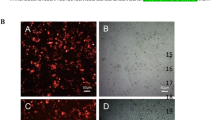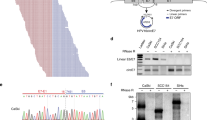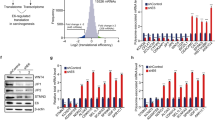Abstract
Selective silencing of mammalian gene expression has recently been achieved using short interfering RNA (siRNA). Synthetic siRNA targets homologous mRNA for degradation and the process is highly efficient. Here we demonstrate siRNA silencing of pathogenic viral gene expression. As a well characterized model we chose cervical carcinoma cells positive for human papillomavirus type 16. Over 90% of human cervical cancers are positive for papillomavirus and abnormal cell proliferation is driven by co-operative effects of viral E6 and E7 genes. We sought to silence HPV E6 and E7 gene expression using siRNAs to target the respective viral mRNAs. Our results indicate selective degradation of E6 and E7 mRNAs. Silencing was sustained for at least 4 days following a single dose of siRNA. E6 silencing induced accumulation of cellular p53 protein, transactivation of the cell cycle control p21 gene and reduced cell growth. In contrast, E7 silencing induced apoptotic cell death. HPV-negative cells appeared unaffected by the anti-viral siRNAs. Thus we demonstrate for the first time (i) that siRNA can induce selective silencing of exogenous viral genes in mammalian cells, and (ii) that the process of siRNA interference does not interfere with the recovery of cellular regulatory systems previously inhibited by viral gene expression.
This is a preview of subscription content, access via your institution
Access options
Subscribe to this journal
Receive 50 print issues and online access
$259.00 per year
only $5.18 per issue
Buy this article
- Purchase on Springer Link
- Instant access to full article PDF
Prices may be subject to local taxes which are calculated during checkout






Similar content being viewed by others
References
Aguilar-Lemarroy A, Gariglio P, Whitaker NJ, Eichhorst ST, zur Hausen H, Kramer PH, Rosl F . 2002 Oncogene 21: 165–175
Baker CC, Phelps WC, Lindgren V, Braun MJ, Gonda MA, Howley PM . 1987 J. Virology 61: 962–971
Butz K, Shahabeddin L, Geisen C, Spitkovsky D, Ullmann A, Hoppe-Seyler F . 1995 Oncogene 10: 927–936
Butz K, Geisen C, Ullmann A, Spitkovsky D, Hoppe-Seyler F . 1996 Int. J. Cancer 68: 506–513
Caplen NJ, Parrish S, Imani F, Fire A, Morgan RA . 2001 Proc. Natl. Acad. Sci. USA 98: 9742–9747
Carthew RW . 2001 Curr. Opin. Biol. 13: 244–248
Elbashir SM, Harborth J, Lendeckel W, Yalcin A, Weber K, Tuschl T . 2001 Nature 411: 428–429
Fire A, Xu S, Montgomery MK, Kostas SA, Driver SE, Mello CC . 1998 Nature 391: 806–811
Gu W, Pan F, Zhang H, Bassell GJ, Singer RH . 2002 J. Cell Biol. 156: 41–51
Hengstermann A, Linares LK, Ciechanover A, Whitaker NJ, Scheffner M . 2001 Proc. Natl. Acad. Sci. USA 98: 1218–1223
Hietenan S, Lain S, Krausz E, Blattner C, Lane DL . 2000 Proc. Natl. Acad. Sci. USA 97: 8501–8506
Ketting RF, Fischer SE, Bernstein E, Sijen T, Hannon GJ, Plasterk RH . 2001 Genes Dev. 15: 2654–2659
Knight SW, Bass BL . 2001 Science 293: 2269–2271
Koromilas AE, Li S, Matlashewski G . 2001 Cytokine Growth Factor Rev. 12: 157–170
Levine AJ . 1997 Cell 88: 323–331
Lipardi C, Wei Q, Paterson BM . 2001 Cell 107: 297–307
McMurray HR, Nguyen D, Westbrook TF, McAnce DJ . 2001 Int. J. Exp. Pathol. 82: 15–33
Mosner J, Mummenbrauer T, Brauer C, Sczakiel G, Grosse F, Deppert W . 1995 EMBO J. 14: 4442–4449
Novina CD, Murray FM, Dykxhoorn DM, Beresford PJ, Reiss J, Lee S-K, Collman RG, Lieberman J, Shankar P, Sharp PA . 2002 Nature Med. 8: 681–686
Nykanen A, Haley B, Zamore PD . 2001 Cell 107: 309–321
Orphanides G, Reinberg D . 2002 Cell 108: 439–451
Patel D, Huang SM, Baglia LA, McCance DJ . 1999 EMBO J. 18: 5061–5072
Scheffner M, Werness BA, Huibregtse JM, Levine AJ, Howley PM . 1990 Cell 63: 1129–1136
Scheffner M, Münger K, Byrne JC, Howley PM . 1991 Proc. Natl. Acad. Sci. USA 88: 5523–5527
Scheffner M, Huibregtse JM, Vierstra RD, Howley PM . 1993 Cell 75: 495–505
Sharp PA . 2001 Genes Dev. 15: 485–490
Steele C, Cowsert LM, Shillitoe EJ . 1993 Cancer Res. 53: 2330–2337
Thomas M, Pim D, Banks L . 1999 Oncogene 18: 7690–7700
Zamore PD, Tuschl T, Sharp PA, Bartel DP . 2000 Cell 101: 25–33
zur Hausen H . 2000 J. Natl. Cancer Inst. 92: 690–698
Acknowledgements
We thank Professor Tim Skerry (Royal Veterinary College, London) and Dr Su Metcalfe (Department of Surgery, University of Cambridge) for critical reading of the manuscript. This work was funded by a programme grant from Yorkshire Cancer Research to J Milner.
Author information
Authors and Affiliations
Corresponding author
Rights and permissions
About this article
Cite this article
Jiang, M., Milner, J. Selective silencing of viral gene expression in HPV-positive human cervical carcinoma cells treated with siRNA, a primer of RNA interference. Oncogene 21, 6041–6048 (2002). https://doi.org/10.1038/sj.onc.1205878
Received:
Revised:
Accepted:
Issue Date:
DOI: https://doi.org/10.1038/sj.onc.1205878
Keywords
This article is cited by
-
Exploitation of ATP-sensitive potassium ion (KATP) channels by HPV promotes cervical cancer cell proliferation by contributing to MAPK/AP-1 signalling
Oncogene (2023)
-
Silencing E6/E7 Oncoproteins in SiHa Cells Treated with siRNAs and Oroxylum indicum Extracts Induced Apoptosis by Upregulating p53/pRb Pathways
Applied Biochemistry and Biotechnology (2023)
-
E6-mediated activation of JNK drives EGFR signalling to promote proliferation and viral oncoprotein expression in cervical cancer
Cell Death & Differentiation (2021)
-
Genetic analysis of human papilloma virus 16 E6/E7 variants obtained from cervical cancer cases in Chhattisgarh, a central state of India
VirusDisease (2021)
-
Bacteria-mediated delivery of RNAi effector molecules against viral HPV16-E7 eradicates oral squamous carcinoma cells (OSCC) via apoptosis
Cancer Gene Therapy (2019)



